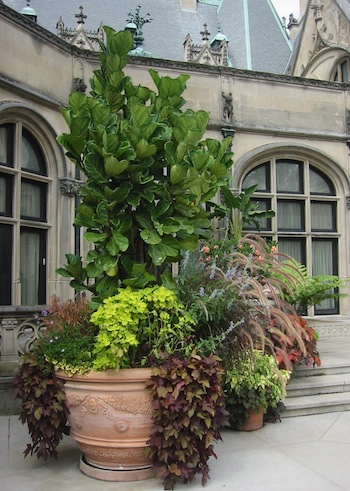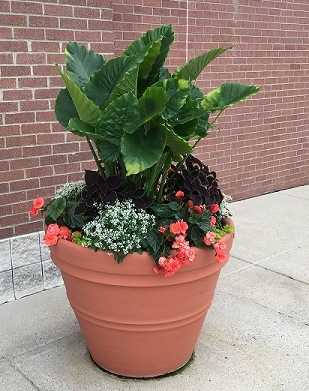Container Gardening
The right pot in the right spot
by Elizabeth Cornell Fake, Fairfax Master Gardener
 Everyone loves attractive containers filled with seasonal plants, greenery or vegetables, and creating them is easy, if you follow a few guidelines. Over the next few months, Fairfax Gardening will look at three aspects of container gardening–containers, conditions, and contents–to help you develop the knowhow to create your own beautiful and productive pots.
Everyone loves attractive containers filled with seasonal plants, greenery or vegetables, and creating them is easy, if you follow a few guidelines. Over the next few months, Fairfax Gardening will look at three aspects of container gardening–containers, conditions, and contents–to help you develop the knowhow to create your own beautiful and productive pots.
This month, we will target the key step: selecting the right container. Here, remember the three S’s: site, size and style. Begin by deciding where you will place – or site – your container garden. If you are planning to put it outside in a large expanse of lawn or on a patio area, the scale of the container should blend well with the surroundings. If it is a large area, choose a large container. If your site will be a window sill or kitchen counter, opt for something to fit that space
Site
Be sure to consider the site’s sun exposure as well when choosing a container. If the site has full-sun exposure with 6-to-8 hours of direct sun per day, a good choice would be a container made of material that is a heat insulator. Any kind of ceramic or terracotta container will keep the plants cooler in full-sun exposure. A metal container is a heat conductor and will get very hot in a full sun. To avoid having to water continuously, stick with a container made of a good heat-insulating material.
Size
 Size is the second question to consider. Container gardens normally end up being about two to three times the size of the container used. If you are going to have a very large container, position it at the site you’ve selected before you begin planting the garden. It may be very difficult to move later, once it is filled with dirt, organic material and plants. Also, if you are going to plant tomatoes or other vegetables with large root systems, choose a tall container that allows room for roots.
Size is the second question to consider. Container gardens normally end up being about two to three times the size of the container used. If you are going to have a very large container, position it at the site you’ve selected before you begin planting the garden. It may be very difficult to move later, once it is filled with dirt, organic material and plants. Also, if you are going to plant tomatoes or other vegetables with large root systems, choose a tall container that allows room for roots.
Style
Style of container is always an important consideration. If you are going to leave your container garden outside, you will want a sturdy container that can withstand the extremes of weather. Good choices include traditional terracotta pots, half barrels, metal tubs, wooden planters, polyresin bins, ceramic or wooden window boxes, vinyl planters, and cement or stone vases. Any nursery or garden supply store will have dozens of choices. Some outdoor containers also feature a self-watering system that can keep your garden alive if you plan to be gone for awhile.
Styles for indoor containers can range from ceramic bowls to native baskets. A good idea for indoor container gardening is to plant the garden in a plastic liner and then insert it into the container. A final word on style is to select a container that contrasts in color or surface to the plants you will choose for the garden. If you are going to have an array of colorful, textured plants, then a simple container will provide a good contrast. If you are interested in a highly decorative container, choose simple plants to focus attention on the container. A bright, white container is a good contrast for an all-green plant selection. A brass or other metal container shows brightly-colored plants to advantage.
 This container at a mall in Fairfax illustrates several points: The size is 4.5 feet by 3.5 feet to scale adequately against an expansive site, a 20-foot brick wall. The container is made of terracotta, a good heat insulator for the full-sun exposure. The style of the container is simple to contrast with a lively selection of plants.
This container at a mall in Fairfax illustrates several points: The size is 4.5 feet by 3.5 feet to scale adequately against an expansive site, a 20-foot brick wall. The container is made of terracotta, a good heat insulator for the full-sun exposure. The style of the container is simple to contrast with a lively selection of plants.
More information
Container and Raised-Bed Gardening, Virginia Cooperative Extension Publication 426